Typhoon Hagibis sweeps away bags full of radioactive Fukushima waste as Japan’s authorities say nothing to worry about (VIDEOS)

Tons of nuclear-contaminated debris were dumped into Japan’s Furumichi River when devastating Typhoon Hagibis washed away numerous bags of poorly-secured Fukushima waste – but the Environment Ministry won’t say how many.
An unknown number of bags, each holding up to one ton of contaminated soil and vegetation from the Fukushima site, were swept away from a storage site in Tamura when the river flooded under heavy rains caused by the typhoon over the weekend.
At least 17 bags have since been recovered – but 10 of those, found caught in trees along the river on Wednesday, had spilled their radioactive contents into the water – and the Environmental Ministry remains silent on how many bags are still missing.
【Exclusive】①福島県田村市から発表。本日下流域を捜索したところ、新たにフレコンバッグ10袋を発見。中は空になっており、除染廃棄物は川に流出したと結論づけた。実は私は朝から現場に張り込んでいた。狙い通り環境省調査団が来たので勝手に同行取材。一部始終を録画しています pic.twitter.com/QWMBE29sb6
— 三浦英之 「牙」が本屋大賞ノミネート (@miura_hideyuki) October 16, 2019
Containing radioactive grass, leaves, dirt and wood, collected during decontamination efforts at the Fukushima site following the 2011 meltdown, some 2,667 bags were left out in the open without even a sheet placed over them for protection from the storm at the Tamura storage site, local media reported. The Environmental Ministry has not said how many bags remain, only that “most” of the bags stored there and at another outdoor site in Iitate remain in place.
“The concentration of radioactive materials is relatively low and has little impact on the environment,” the ministry told Kyodo News, insisting there was no increase in measured radiation either in the area where the bags were stored or in the river itself.
福島県田村市、原発事故の除せん廃棄物を詰めたフレコンバッグが流出した現場です*2 激しい台風で積み上げられたフレコンバッグが崩れてしまっています pic.twitter.com/Ii2IPJz8Vl
— 三浦英之 「牙」が本屋大賞ノミネート (@miura_hideyuki) October 13, 2019
Hagibis, the most powerful typhoon to hit Japan in decades, caused flooding in 200 rivers, dropped record rainfall in some areas, and was preceded by a magnitude 5.7 earthquake off the coast of Chiba. At least 74 deaths have been attributed to Hagibis, and rescue teams are still searching for survivors, with 14 people remaining unaccounted for as of Tuesday night. Nearly 10,000 homes were flooded and hundreds of thousands of police, coast guard, firefighters, and auxiliary personnel are participating in the search and rescue effort.
Also on rt.com Dozens killed as Typhoon Hagibis wreaks flooding and devastation on Japan (PHOTO, VIDEO)The catastrophic three-reactor meltdown at Fukushima eight years ago was triggered by a similar environmental disaster, with a simultaneous earthquake and tsunami wreaking havoc on northeastern Japan. Japanese authorities have consistently sought to downplay the fallout from the Fukushima disaster and announced earlier this month their plans to “dilute” radioactive wastewater from the plant by dumping it into the ocean when storage capacity is exceeded – horrifying neighboring countries, fishermen, and environmental advocates.
Also on rt.com Permission to dock: Russia’s floating nuclear power plant reaches Arctic port it was built forLike this story? Share it with a friend!













